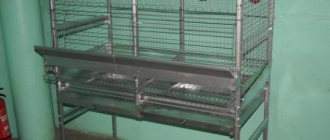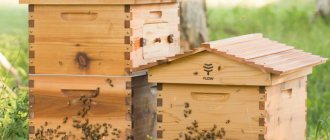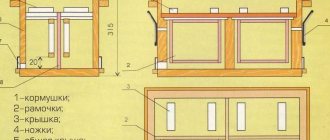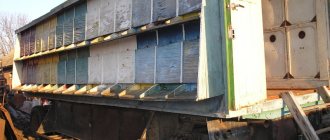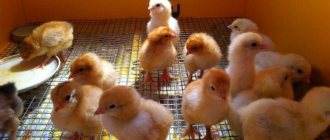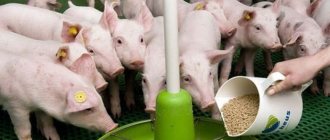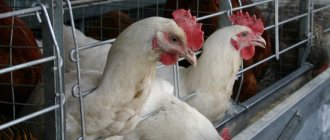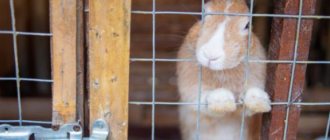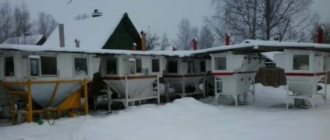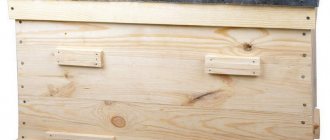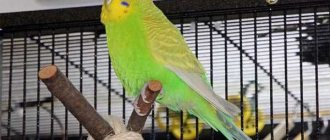Group cage for young animals
Group structures are used for keeping young animals. Depending on the size of the enclosure, there are from 8 to 20 rodents in the cage. The animals are kept together as long as they have enough space. When the sex of the individual becomes possible to determine, the rodents are seated. It is recommended to keep no more than three individuals over three months old in one cage.
When making cages for rabbits with your own hands, it is recommended to strengthen the walls and doors in the cages of young animals so that the animals do not chew through the structure. A mesh floor is installed in the nursery to protect rabbits from the spread of pathogenic bacteria and parasites.
The minimum area of the enclosure for two individuals is sq. m. Height - at least 0.35 m. The size of the structure depends on the number and age of rodents.
Enclosures for outdoor placement are built on one, two or three floors. It is recommended to raise the floor above the ground by 0.35 m. In winter, it is necessary to insulate the enclosures by adding straw to the floor.
Natural materials are used to construct the structure, since artificial ones negatively affect the health and development of rodents.
When designing, it is important to pay attention to the lighting and location of the cage. Young animals need protection from drafts and dim light. Adults tolerate cold and temperature changes better (depending on the breed). But for the winter, cages with young and adult animals are insulated.
What should a rabbitry be like?
In order for rabbits to feel normal, not get sick, grow well and reproduce quickly, they need to create a certain atmosphere. They are demanding of living conditions and often get sick in poor conditions. To prevent this from happening, they need the following conditions:
- The optimal temperature is 14-16°C. The temperature in the rabbitry is determined in a place away from heating devices, walls, windows and doors. Both overheating and hypothermia have a negative effect. When the temperature drops, more feed is required, which is unprofitable. But a gradual rise or fall in temperature is not as destructive as sudden changes. From all this it follows that it is necessary to build an insulated rabbitry, with the possibility of heating and air conditioning. The most justified are rabbit hutches built using frame technology, with mineral wool insulation (thickness is calculated depending on the region). No less attention should be paid to the insulation of the floor and ceiling. The roofing material may not be insulated; it must provide protection from moisture. In this case, it is necessary to take care of the insulation of the ceiling. The cheapest way is to pour a layer of expanded clay onto the ceiling, apply a layer of clay mixed with straw on top, and then you can even throw fallen leaves onto the dried clay for additional thermal insulation.
Certain conditions are required for normal well-being - Rabbits are demanding of air humidity - it must be maintained at 60-75%.
- Drafts have a negative effect on the health of rabbits. This is another argument in favor of frame buildings - if constructed correctly, there should be no drafts. However, the rabbitry must have ventilation because they need fresh air and the gases that come from the rabbits' urine and feces must be removed. But the air speed should not be more than 0.3 m/s. Usually, an inlet opening is made, covered by a movable grille at floor level in one corner of the rabbitry, and an exhaust pipe under the ceiling in the other. You can install a damper in the exhaust pipe. Using a movable grille and a damper, you can regulate the speed of air movement in the rabbitry depending on weather conditions. If natural ventilation is not enough, fans with the ability to regulate the speed of rotation of the blades are installed in the exhaust or supply pipe (there should be several modes).
- The second factor that affects the state of the atmosphere in a rabbitry is the regularity of cleaning and the design of the cages. About the cells - a little lower, and here - about cleaning. It should be regular - at least 2-3 times a week. The main indicator is the presence or absence of a strong odor.
- In order for less ammonia to be released, it is necessary to organize the collection of stool so that urine is separated from feces. If the collection goes into trays under the cages, they have a slope and a trench through which the urine is drained into a separate container. If waste is collected through gutters into a pit (with large numbers of rabbits), the ditches must be made so that urine leaks into a lower gutter separated by a mesh. This is a rather difficult task, since one part is separated from the other using a mesh, and it often gets clogged. To keep everything in working order, you have to clean it often.
Construction of a rabbitry is a serious matter
The rate of weight gain and fur density are also affected by the illumination of the rabbitry and the length of daylight hours. Rabbits are most active at dusk and at night. Bright lighting is undesirable for them. A sufficient level of illumination is 50-70 lux for adults, 25-30 lux for fattening young animals. At the same time, the duration of daylight hours is 16-18 hours, so in winter lighting is required, but dim. To make the lighting more comfortable when servicing the rabbitry, install several additional light bulbs above the cages, but connect them to the second switch (or to the second key). Another option is to install a brightness control (dimmer). It is installed instead of a regular switch and allows you to change the illumination by turning the control knob.
Cage for adult rabbits
The size of rabbit cages depends on the age and sex of the rodent. Females with young animals are kept in large cages. For a regular rabbit, the cage parameters are 0.7 m wide, 0.6 m high and 1 m long.
For an adult, the size of the enclosure should be increased to 0.8 m in width, 0.5 in height and 1.5 in length. In dwellings of this size, rodents feel freer, develop faster and grow better.
It is recommended to construct the floor from slats or a solid one with a mesh insert. Some rabbit breeders divide the animal's housing into a feeding part and a queen cell (for breeding rabbits).
Ventilation is considered an important stage when designing rabbit housing. The rabbitry should be well ventilated, protected from drafts and bright sunlight. The duration of daylight hours is from 8 to 16 hours. Attention should be paid to cleaning enclosures. Adults should be inspected during cleaning, and disinfection measures should be carried out in the cage.
Tips and tricks
The optimal temperature for rabbits is 18-20 degrees. If the room where you want to place the cages is cold, then you should take care of additional heating.
The location of the cells depends on the region. The best option is to place the cages outside in the summer and in a barn in the winter. Place cages away from drafts and wind, as the weakest animals can get colds and infect others.
If you have a large summer cottage or your own farm, build cages for rabbits with your own hands without legs with a large feeding compartment made of mesh. Thus, the rabbits will eat fresh grass, which will create optimal conditions for reproductive function.
Another feature is that rabbits do not like a lot of light, so placing cages in the sun is not entirely correct. But they still need lighting. If you are placing the cages in a shed, make sure to keep the interior lights on low for 8-10 hours a day.
For the construction of cages, the following are used: wooden beams, galvanized mesh with small mesh sizes, metal slats, plywood and roof tiles. Before introducing rabbits into cages, carefully check the wood for burrs. If there are any, sand them using sandpaper. Rabbits are very delicate animals and can easily hurt themselves.
Do not use solid metal plates to construct walls, floors or roofs. This material holds temperature very well. If it's too hot in the summer, it heats up and the rabbits get hot; if it's too cold, it freezes. Rabbits will not be comfortable in such cages and may lose their ability to reproduce.
The following additional materials and tools are used: jigsaw, electric screwdriver, sandpaper, screws, self-tapping screws, door hinges, wood knife, nails, hammer, tape measure, screwdriver, metal scissors. It is recommended to use small screws and nails so that their edges do not protrude into the inside of the cage. They should be hammered or screwed in such a way that the head of the nail or screw cuts into the wood by 1-2 millimeters. For more details, watch the DIY rabbit cages video.
The size of the cage should correspond to the size of the rabbits. For one adult male weighing up to 5 kilograms, a cage measuring 0.6 meters in width and height and at least 1 meter in length is suitable. For larger individuals, the cage size should not be less than 1.3*1.3*0.8 meters.
For babies, the cage should be large in size so that from 6 to 12 rabbits can fit in it. The dimensions of such a cage should not be less than 2*3*0.6 meters. One adult rabbit accounts for about 0.7-0.9 square meters, and one small rabbit - 0.2-0.3 square meters.
By adhering to these simple rules, you can provide the most comfortable living conditions for your rabbits.
Two-tier shed
A two-tier shed is a two-story structure consisting of several cages placed in a row. The installation of such dwellings helps to save space and simplify the care of animals. It is recommended to use this type of outdoor maintenance in regions with warm climates or in heated rooms. Sheds are also installed outdoors in the summer.
It is important to build housing, raising it above the ground to a height of 0.5 m. The optimal dimensions of the structure are 2 m wide and 1 m deep. Two-tier sheds can be made independently using a one-sided type from boards, slate and metal mesh.
It is recommended to concrete the foundation to increase the stability of the structure. To simplify the care of animals, experienced rabbit breeders install manure channels and trays. This method makes cleaning easier and reduces the risk of disease.
Sheds allow you to keep several rabbits at the same time. Drawings created at the design stage can be used to create additional rows. All cells in a structure are created the same way. A canopy is installed over the sheds. The structures are installed close to each other.
In warm regions, shad keeping is possible all year round. In winter, water for rabbits is heated. The space between the cells is allocated for storing hay and grass. For feeding, waste-free systems are installed that need to be replenished every 3-7 days.
The bunker feeder is made independently from metal sheets. In the warm season, it is possible to use automatic drinkers. Transitions are installed at an angle to the exit. The back wall is solid. The cage has several windows with bars. In cold weather, windows are closed with wooden sheets or folding doors. In the passage between the shads, a suspended structure is built for transporting feed.
Dimensions and drawings
Before starting construction, you should decide who will live in the house, prepare a model: calculate the parameters, draw up drawings, draw sketches of the future structure. The floor is made of timber. The slats are laid out at intervals so that animal waste is dumped into the tray. The side and back walls are made of boards. A chain link is stretched on the front part. The house is equipped with a feeding trough, a drinking bowl, and a hay barn. The manger and the entrance inside are covered with mesh so that rabbits do not damage them.
Drawings of a cage for young animals
Young rabbits are housed in numbers of 6-10 for slaughter, and no more than 5-6 for breeding. They are kept in a large, capacious cage, to which an enclosure is attached.
To create an accurate drawing, calculate the minimum area that one individual will occupy. For babies it is 0.15 m². It reaches no more than 3 m in length, 1 m in width, and 0.7 m in height.
The pen dimensions are identical. The floor is covered with beams, and a metal mesh is stretched around it. To get into it, they make a hole.
Drawings of an adult rabbitry
For adult representatives, the unit of occupied area for calculating the total increases to 0.5 m². Cages with separate sections are built for them. If necessary, they can be made multi-tiered, but preference is given to single-tiered ones.
Multi-level structures are more difficult to keep clean.
The dimensions of the houses depend on the breed, age, and sex of the rabbit. Adults are placed in groups of 3 in a single section, and 5-6 in a double section. Section dimensions: 0.8-1.1 m, for double the entire length is 1.3 m; minimum depth 0.6 m.
Young males that have reached the age of three months are divided into two groups: the slaughter ones are castrated and housed together, the breeding ones are seated one at a time. For purebred rabbits, houses with dimensions of 0.7 x 0.7 x 0.6 m are made.
Options for drawings, all pictures are clickable, click to enlarge:
Two-tier shed
It is a structure made up of sections built in several levels. Such structures are used in street maintenance. Installed at a height of 0.6 m from the ground.
To build the foundation, concrete is used to securely secure the structure. The total length reaches 2 m, width - 1 m. All cells in the shed are identical, stand close to each other, covered with a canopy. A waste tray is arranged at the bottom.
The advantage of this type of housing is that the animals spend the entire spring and summer in the fresh air. Cleaning the houses does not take much time and effort.
Options for drawings of two-tier sheds, click on the picture to enlarge it:
Dimensions of rabbitry with queen cell
A portable house for a pregnant or lactating female and babies is built separately from other structures. To calculate the occupied area, take 0.7 m² per unit. Standard dimensions:
- length - 1.2 m;
- width - 0.6 m;
- height - 0.7 m.
The mother liquor is made with a separate door or a retractable one, its parameters are: 0.4 x 0.7 x 0.6 m. The hole is 0.2 x 0.2 m. The frame is made of plywood, in two layers, between which insulation is laid.
For the winter version, the floor is heated: a heating pad is placed between the layers, the cord for connecting to the network is brought out so that animals do not chew it off. The roof is covered with water-repellent material.
Drawings of a rabbitry with a queen cell, click on the photo to enlarge it:
Double cages
Used to house several animals. A nesting compartment is attached to the sides. The frame is built from boards, the floor in the aft section is covered with mesh, and in the mother section - with timber. For roughage, a manger is made on the front wall. The drinking bowl and feeder are hung on the door.
Options:
- length 2.1-2.4 m;
- width 0.7 m;
- the height of the facade is 0.5-0.6 m, with a bevel towards the rear wall, at which it will be 0.4 m.
Drawings of Zolotukhin's rabbitry
Nikolai Ivanovich Zolotukhin studied the behavior and lifestyle of rabbits in the wild for many years. Based on the researched information, he developed a structure for comfortable housing of animals at home. These are three-tier cells with the following parameters:
- length 2 m;
- width 0.8 m;
- height 1.5 m;
- the floor from the rear facade is 0.2 m covered with a metal mesh, the slope from the front wall to it is 0.05 m;
- square doors, side length 0.4 m.
Variants of drawings according to Zolotukhin. Click on the picture to enlarge it:
For construction you will need:
- wooden boards, beams;
- chain-link or metal mesh;
- iron sheets;
- slate;
- polycarbonate
Construction scheme:
- Making the frame using the standard method, dividing it into two parts with a gap between them. A hay box is placed there.
- The floor is covered with slate, retreating 0.2 m from the rear facade. A mesh is stretched over this area.
- The back is covered with polycarbonate. The sheets are installed at a certain angle and directed towards the end of the slate of the upper tier. At the very last floor the sheet will be straight. This serves to make cleaning the cells easier. Waste is rolled through a mesh in the floor into a tray along the back wall.
- In the case of a nesting compartment, the door is made of boards with insulation between the layers. The main part is made of mesh.
- The walls in the summer compartment are also made of mesh, separated by a partition. In winter, it is removed and a large house is obtained for keeping young individuals.
- The feeder is attached to the front wall, with one third part located inside. The bottom is angled so that it can be filled from the outside without disturbing the animals. The sippy cup is installed inside.
Mikhailova's rabbitry
Another model belongs to the famous rabbit breeder Igor Nikolaevich Mikhailov. It is based on dividing the room into three sections: upper, lower, and stand.
Each of them performs its own function: the top is the tiers where the animals live. The bottom serves as a tray for collecting and storing feces. The stand part is designed to fix the structure.
Variants of drawings of Mikhailov's rabbitry. Click on any picture to enlarge it:
Design dimensions:
- total length is 2.4 m, for one section it is 0.6 m;
- width 0.6 m;
- height 1 m, including the top part 0.7 m;
- queen cell length 0.4 m, width - 0.35 m;
- There are no clear dimensions for the conical part intended for collecting waste.
The body is made of iron, and the inside is lined with wood for insulation. The frame base serves for the stability of the structure. Its height is 1.4 m.
Double cage with queen cell
For pregnant females, a spacious cage with a queen cell is required - a removable design for rabbits up to one month. The food part occupies most of the cage. A manhole is installed between the compartment. Such housing is intended for two individuals of different sexes or two females with cubs. It is recommended to install a slatted floor.
A cage for a female rabbit with a queen cell, the dimensions of which are 2.2 × 0.6 × 0.5 m, is made from natural material in compliance with all safety rules. Rabbits need comfort for reproduction, proper growth and development.
It is not recommended to use sawdust and small shavings as bedding, as they generate dust and are uncomfortable for rabbits. You should also take care of the convenience of replenishing drinking bowls and feeders.
Metal mesh floor for rabbits - pros
The most important advantage of such a floor is, of course, cleanliness and order . All the rabbit's waste products fall down (on the ground or on a galvanized sheet), which means that the cage needs to be cleaned less.
Read also: How to keep and what to feed dairy goats
We think everyone here will agree that this is a big and undeniable plus.
However, we will not say that cleaning cages with slatted wooden floors is difficult or time consuming. There is rather a choice between “very convenient” and “just convenient”.
Dimensions of cages for Zolotukhin rabbits
N.I. Zolotukhin’s cells are widely known among rabbit breeders. The distinctive features of the designs are:
- No pallets.
- Wooden or slate flooring.
- Inclined installation of rear walls.
- Near the back wall, a mesh is built into the floor.
The dimensions of the cage with the queen cell, which is also removed, are 0.7 by 1 m. To ensure the safety of the cubs, a board is installed in front of the door. The queen cell is located in a common cage, fenced off from the rest of the space with an additional board. It is possible to place the aft compartments one above the other. On the Internet you can find cages installed in 3 tiers, photos, sizes, drawings of which are also available to rabbit breeders.
There are also Maklyakov cells - modular systems in which the purpose of the cell can be easily changed. The design uses heated drinking bowls and modern waste removal systems. Infrared heating is used in the aft compartment.
Cage sizes for California rabbits
Rabbits of the Californian breed are unpretentious in keeping. The variety is a mixture of Soviet chinchilla, New Zealand and ermine breeds. The size of the cage for the Californian rabbit is smaller than the enclosures for giant rabbits. The variety is frost-resistant and can be kept without bedding. A dwelling with a feeding section is designed with a size of 0.4 sq. m. m. To keep one rodent, 0.3 square meters is enough. m. The hard hair on the paws allows rodents to be kept on mesh floors. In block structures, it is recommended to exchange animals of the same age category next to each other to simplify care.
Pit housing is recommended when breeding rabbits for meat. Conditions are as close as possible to real ones, so animals grow, develop and gain weight faster.
Setting up a pit for rabbits is quite simple:
- it is necessary to dig a recess with parameters 2x2x1 m,
- strengthen the walls with slate sheets or concrete;
- put boards or mesh on the floor;
- construct a fence and a canopy on the surface.
It is recommended to monitor rabbits to prevent mating of close relatives, as this worsens the performance of the animals. It is necessary to have water and food in the pit, as well as regular preventive examinations of rodents.
California rabbits are fed dairy products, fish and meat meal, and nutritional protein supplements. The variety is gaining popularity among rabbit breeders due to its ease of breeding, quality of fur and meat. Female rabbits give birth to 6–8 young rabbits, sometimes in a litter of up to 12 babies.
Floors for rabbits
Questions can only be asked after registration. Please login or register.
I propose to share my thoughts and ideas (may not yet be implemented) for improving, improving, simplifying rabbit houses and their components (floor, feeder, drinking bowl, hay barn, walls, etc.)
In this topic we discuss flooring for rabbits
Now my rabbit houses have a regular floor made of pine boards. I recently saw a plywood floor like this somewhere. I think it’s easier to make and simpler, it will be lighter in weight and more convenient to install, I drew it out and cut it where needed. jigsaw And rabbits don’t seem to chew plywood. Please share your thoughts on this matter.
Theoretically - a good idea, in practice - it is unknown whether the floor will sag or not.
Alexander, waterproof plywood is treated with a special solution, if we disturb this coating, it will swell in layers from urine. And Slava, as he writes correctly, will bend. And I think it’s easier to make slats. Let’s wait, maybe someone has experience.
Bakelized.))))))) They sawed it for 2 weeks.)))))) All the files were sharpened with a jigsaw and it burned.)))) It was sawed with a special machine. )))) She goes to the floor of trolleybuses and buses. There is no demolition for her.)))))
Bakelized.))))))) They sawed it for 2 weeks.)))))) All the files were sharpened with a jigsaw and it burned.)))) It was sawed with a special machine. )))) She goes to the floor of trolleybuses and buses. There is no demolition for her.)))))
This is what any milling machine operator can do for a bottle on a simple milling machine. The work is not difficult. You can use a conical cutter, it will be great. But probably these slots are better not at an angle, but at a right angle to the front wall, and it’s easier to make, and subsequently it’s easier to clean the floor.
And it's terribly heavy. Not an option for cells.
And it's terribly heavy. Not an option for cells.
Probably not necessarily 10 mm, maybe twice as thin. In terms of strength, it’s probably quite suitable, and besides, there are advantages: it’s cheaper, it’s easier to process, and, of course, it will be lighter in weight. In terms of strength, they are much stronger than plastics, and in terms of sanitary properties, they are a complete replacement, and rabbits will not chew them. Bakelite plywood is 2.5 times lighter in weight than aluminum.
I'm becoming more and more of an OSB proponent. And it is made in Germany.
The best option for getting rid of diseases in cells is a blowtorch. And as poop easily fades and can’t be washed, it’s a beauty in general.
I got the impression that in this topic it is proposed to discuss all the issues under the “Construction” section. The Bureau".
Read also: Anatomy of a cow: skeletal structure, skull shape, internal organs
IMHO this is a bad idea.
If we are discussing floors, then the topic should be “Floors for rabbits” or something similar, but it’s not clear what to read about where.
Ok, let's discuss "Floors for Rabbits".
Now I’ll figure it out properly and punish anyone. Please follow OUR RULES
What if you paint a plywood floor well with polyurethane varnish? If you paint with a simple paint (for example, nitro enamel), I agree, after a while water will still get into the layers of plywood.
What if you paint a plywood floor well with polyurethane varnish? If you paint with a simple paint (for example, nitro enamel), I agree, after a while water will still get into the layers of plywood.
In any case, this will be temporary protection, maybe it will last a little longer. Rabbits, due to their harmfulness, will still scratch or chew through this varnish. Today, by the way, I watched how they chew a metal bar, there is no chance and there are pieces of wood in the cages for gnawing, but he still needs to chew this bar.
Optimal cage sizes for rabbits
The standard dimensions of a farm rabbit hutch are 1.5 x 0.8 x 0.5 m. It is recommended to install a mesh door and a mesh insert in the floor.
A cage for a decorative rabbit must be at least 0.9 m in length and 0.7 m in width. At the same time, the animal has enough space to move and play. The height of the cage is determined by the “growth” of the animal.
Housing of the same dimensions is arranged for a dwarf rabbit. Be sure to install comfortable drinking bowls and feeders, and add toys to your pet so that he doesn’t get bored.
Features of keeping rabbits in a mesh cage
Mesh cages for rabbits, although compact and easy to clean, are impractical for raising animals, especially outdoors. You can improve the quality of your pets' living conditions.
Experienced breeders advise: - provide homes with a layer of good dry bedding and monitor its condition; — protect the houses from drafts by covering several sides with non-blown material; — place food only in feeders to prevent overspending.
All other rules for keeping animals in mesh cages are completely similar to other types of structures.
What kind of mesh is needed for rabbit cages (types of mesh)
Rabbits love to chew everything in their path. Therefore, durable materials are used to build houses. The best option is a metal mesh for cages.
Popular types of cage nets: chain-link, metal, galvanized
Basic rules for choosing a grid
The best choice is a metal mesh for rabbits. But when purchasing such material, it is also worth considering a number of nuances:
- we clearly select the size of the mesh, taking into account the purpose of use - door, walls, floor (initially we calculate how much mesh will be needed for manufacturing);
- the mesh for cells should have a cell diameter of 1.5 - 2 cm;
- We take into account the quality of the proposed mesh.
Experienced breeders say that the best mesh is welded with hot-dip galvanizing (sagging on the seams after welding is visible). They also note what the geometry of the cells is (if welding is poor, the curvature is very noticeable). Mesh material with very thin rods is also not suitable - no more than 2mm.
Video Technology for making cages from mesh
